Vol. 4インタビュー シンク・シティ
ボトムアップのアプローチ ―― 多くの‘小さな力’のインパクト
Bottom-Up Approach ―― Impact of many ‘power of small’
vol.4 インタビュー シンク・シティ、マレーシア
Interview Column 4: Think City, Malaysia
2015年より協議会で実施している「ASEAN諸国における企業メセナの促進とネットワーク構築に向けた調査・協議」(助成:国際交流基金アジアセンター)。本年は、この3年間交流を深めた各ASEAN文化団体へのインタビュー・コラムや、視察レポートを連載しています。
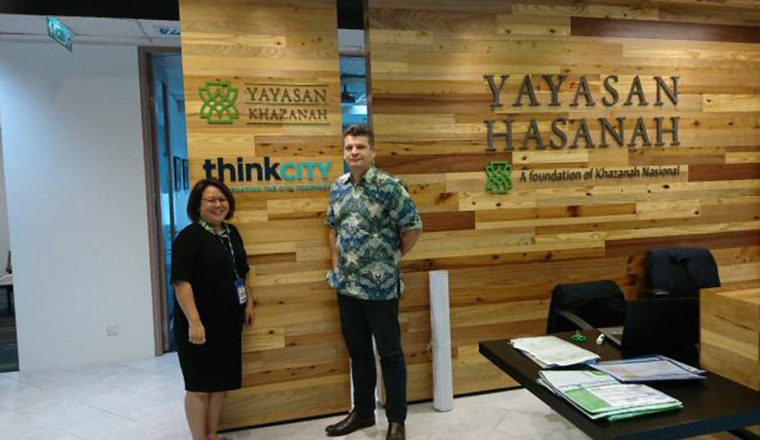 左から(From left)ジア・ピン・リー (クアラルンプールプログラム・ディレクター、コーポレートコミュニケーション部長)
左から(From left)ジア・ピン・リー (クアラルンプールプログラム・ディレクター、コーポレートコミュニケーション部長)
Jia Ping Lee (Programme Director KL and Corporate Communications Head)
ダンカン・ケイブ(プログラム・マネージャー/アーバン・ナレッジ)
Duncan Cave (Programme Manager, Urban Knowledge)
シンク・シティ
2009年に設立。マレーシア政府の戦略的投資助成機関であるカザナ・ナショナルがオーナー。地域自治体や国際機関、コミュニティと共に、地域課題の長期的・包括的な解決策提案や、効果的なパートナーシップ構築を目指している。
Think City
Think City Sdn Bhd, established in 2009, is a community based urban regeneration organization fully owned by Khazanah Nasional, the strategic investment fund for the Malaysian Government. Think City aims to deliver long term holistic solutions, working closely with local councils, local and international agencies, and various communities, building effective partnerships and enhancing capacity along the way.
――まず、あなたの組織の哲学は何ですか?
Q: So please tell me the philosophy of your foundation.
ジア・ピン(以下ジア):アーバン・ナレッジ(都市知識)でしょうか。
Jia-Ping (Jia): Urban Knowledge
ダンカン:‘小さいものの力’ですかね。
Duncan: ‘Power of small’
ジア:私たちは常日頃コミュニティの人々やパートナーに様々なアイディアを聞いてまわります。 ‘ボトムアップ’のアプローチと呼んでいるのですが、私たちが行っていることに参加してもらい一緒にプロジェクトを進めていくのです。たとえば、小さなプロジェクトを狭い地域で多数行ったとします、そうすると自発的に変化が起こるのです。なぜなら、これはトップダウン(政府から)の依頼・発案ではなく、コミュニティ・社会から起こった現象だからです。
Jia: We basically cloud-source ideas from the community as well as partners. And we get them involved, called bottom-up approach and what happens is when you have multitude small projects happening in confined boundary, change automatically happens. It is because it’s also been driven by not top-down (government down), but by bottom-up.
ダンカン:私たちはいつも調査を行い、エビデンスに基づいたプランニングを行います。しかし、コミュニティ自体が私たちよりも、彼らのコミュニティ再生のための優れたアイディアを持っていることもあります。私たちが彼らと話をすれば、問題が何であるか、解決しなくてはいけないことは何なのか、そういったことに対するアイデアがほぼわかるのです。小さな力と証拠・実論に基づいたプランニングのバランスをとることが大切で、だからこそコミュニティに直接話を聞き、そのコミュニティに必要なものは何かというエビデンスを得ることができるのです。
Duncan: We always do evident-based planning
through researches such as scientific studies. But the community probably have the best ides to which is needed in their community. So if we go and talk to them, say what the problems are, what needs to be fixing, we could likely to get the best solutions. Power small balances with evidence-based planning so you actually are using the community to gather the evidence what needs to be done.
――コミュニティが最も必要とするものは何ですか?経済的支援や、スペースでしょうか?
Q: What does they need most? Finance support? Space support?
ダンカン:たとえば、クアラルンプールでは、金銭支援の重要性は低くなります。彼らが求めているのは、悩みや相談を聞き、今後の方向性について、考え方や、判断、行動のサポートだと思っています。プロジェクトの改善方法を見つける仲介人のように行動しているといえるでしょう。
Duncan: For example, in KL, the finance is less important. I think what people like to get from us is moral support. So we are acting like conduit maybe, trying to find the way to improve the project.
ジア:もう1つの例としては、私たちが助成プログラムを開始したときに、芸術コミュニティは、私たちにスペースを求め続けました。プログラムを開催したい地域にはスペースがない。だから私たちはまずスペースを借りることから始めました。私たちは遺産のあるルアンにスペースを借りました。現在はアート展、ダンスクラスなどのために無償で貸しています。
Jia: Another thing is that arts community, when we first launched the grant, kept asking us for space. Because we don’t have a space in the area where they want to hold the program. So one of the things that we decided to do was to rent the space, so that became a Ruang, space in heritage call. Now we are giving rent-free for arts exhibition, dance classes and so on.
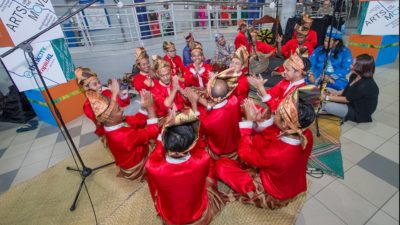
駅構内で行われているパフォーマンス(アーツ・オン・ザ・ムーブ)
Performance at a station (Arts on the Move)
また、LRT駅で毎週火曜日と木曜日にパフォーマンスプログラムを提供しています。‘アーツ・オン・ザ・ムーブ’というプログラムです。私たちはクアラルンプールを文化的かつクリエイティブな地域に変えたいと考えているので、私たちは文化を紹介することから始めました。マレーシア人の問題は自分自身が帰属していない文化の価値を認識しておらず、その上そういった文化に触れる機会もありません。ですから、パフォーマンスを皆に届けに行くことにしたのです。鑑賞者は、チケット代を支払う必要はなく、代わりに電車運賃を払うだけです。
Also we have performances in LRT station every Tuesday and Thursday. This is ‘Arts on the Move’. So one of the things of power of small is that we also want to change the KL into cultural and creative district, so we starting by introducing culture. Because everyday person in Malaysia, doesn’t see the value of culture that is not on their own, and it is not exposed, doesn’t have opportunity. So what we are doing is that we bring the theatre to you, where you don’t have to pay, it is just supply for the train fare.
――ヤヤサン・ハサナ財団(以下、ハサナ財団)の傘下にあるそうですが、が事業資金もハサナ財団が提供しているのでしょうか?
Q: You have mentioned that you are under the umbrella of Yayasan Hasanah? And they give you endorsement.
ダンカン:ヤヤサン・ハサナは財団です。そして彼らは、マレーシア政府が国の発展のため資金投資ししているカザナ財団がオーナーです。ハサナ財団は、毎年資金を得て、分配しています。彼らは、私たちのほかにも支援している多くの団体があります。だから、私たちは資金分配について競争しなければなりません。
Duncan: So Yayasan Hasanah is a foundation. And they are owned by the foundation Khazanah, which is the soloed fund for Malaysia. So Yayasan Hasanah has got certain money they can give out each year, distribute. So they have got a lot of other organization they also support. So we have to compete for our share of the money.
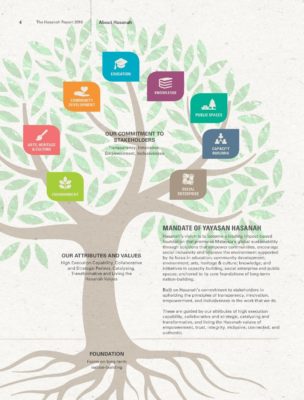
ハサナ財団の支援分野 Yayasan Hasanah’s funding areas
ジア:この図は(左図を参照)、彼らが助成する分野を表しています。支援している他のNGO、NPOもあります。私たちは、公共スペースを含め様々な分野をカバーしていますが、カザナ財団の子会社であるためかなりの資金支援をしてもらっています。
Jia: If you look at this tree (above), it represents the areas which they fund. So they have other NGOs, NPOs. So we fulfill public spaces, we actually fulfill quite a few of these, because we are subsidiary of Khazanah, we can be treated special in a sense.
――ハサナ財団からの資金は公的資金になるのですか?
Q: The source of money you get from Yayasan Hasanah, is that public money?
ダンカン:本質的には公的資金です。カザナ財団は連邦政府が所有しており、連邦政府の投資法人の一種です。だからマレーシア航空もカザナ財団が所有しています。
Duncan: It is essentially a public money, because Khazanah is owned by the federal government, and it is a sort of Investment Corporation for federation government. So Like Malaysian Airline is owned by Khazanah.
ジア:彼らが行うことは、投資先を探すことであり地元の企業に還元したいという願いからです。だから彼らは地元の企業を育てています。カザナ財団が投資するものはかなりたくさんあります。ハサナ財団は、カザナ財団が生み出した利益を基本財産として運営しています。彼らは、これらの資金を別の投資に入れるのではなく、純粋に社会に還元したいと考えました。300万リンギット(日本円にして7,500万)ほどの基本財産があります。
Jia: What they do is to look for assets to investing, which have a good year to come back to local businesses. So they grow local businesses. So there are quite lot of things that Khazanah invests in. So Yayasan Hasanah came out the endowment fund from the profits they made, and they decide to actually want to give back the society, rather than put these money into another investment- this is purly give-back. So there is 3 million RM(approx. JPY 75 million) endowment fund.
――シンクシティの組織体制は?
Q: What is your oragnization’s structure?
ジア:まずシンクシティは理事会のメンバーの一人でもある専務理事によって、運営されています。その上は、ハサナ財団※1の理事・評議員たちがいます。
Jia: Think City is led by executive director who is also a member of board, and Yayasan Hazanah※1 as alos board of trustees.
※1ハサナ財団…多様で、より戦略的アプローチから社会への価値配分を展開すべく、2013年12月にカザナ・ナショナルが設立した姉妹財団。マレーシアの現実的、永続的、社会的かつ環境的変化を生み出すことを目的とし、教育、コミュニティ開発、環境、芸術と遺産および文化、知識、パブリックスペース(公共スペース)の分野で助成・支援を行っている。
※1 In December 2013, Khazanah Nasional Berhad (Khazanah) incorporated a sister entity, Yayasan Hasanah (Hasanah), as an enhanced and more strategic approach to value distribution. Yayasan Hasanah strives to create real and lasting positive social and environmental changes for Malaysia through our work in the following focus areas: Education; Community Development; Environment; Arts, Heritage & Culture; Knowledge; and Public Spaces.
ダンカン:私たちの委員会(理事会)は独立しているものです。そのうち3名はシンクシティの人間ではありません。一人は識者です。
Duncan: Our board is independent. Three of them are completely independent from Think City. One is an intellect activist.
ジア:理事会の会長はNGO活動や社会活動家を支援している人です。
Jia: The chair of the board is also a host of NGO movement and social activist movement.
ダンカン:他に2人外部の人間が理事となっています。一人は弁護士、そしてもう一人は文化遺産などを専門とする建築家です。それから、ハサナ財団からの理事がひとりいます。それから私たちの上司であるシンクシティの専務理事(彼はカザナ※2(政府の投資企業)出身でもありますが)の5人です。常に、公平さを保てるようにチェックしています。
Duncan: We have two other independent lawyer and architect who are very engaged heritage. We have also one from Yayasan Hazannah※2, and executive director (our boss), who is also from Kazannah. That’s the check in balance.
※2 カザナ財団…マレーシア政府の戦略的投資助成機関であるカザナ・ナショナルが所有する財団。マレーシアの政府関連企業(GLC)を含む最高の組織において重要な地位を占める優れた人材の選定、支援、育成を委託されている。 シンクシティは、このカザナ・ナショナルが所有している
※2 Yayasan Khazanah is a foundation established by Khazanah Nasional Berhad (Khazanah Nasional) – the investment holding arm of the Government of Malaysia. It is entrusted to select, support, groom and nurture exceptional individuals’ who will eventually take on high-level positions in the best organisations including government-linked companies (GLCs) in Malaysia. Think City Sdn Bhd is fully owned by Khazanah Nasional, the strategic investment fund for the Malaysian Government.
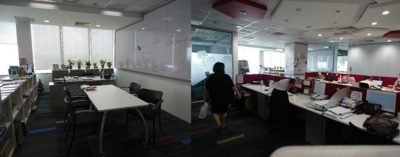
クアラルンプールにあるオフィス Think City’s office in Kuala Lumpur
――シンクシティが支援する分野というものはありますか?
Q: In terms of supporting genres, do you have specifics?
ジア:まず、私たちが達成したいゴールがあります。1つ目は回復力、住みやすさ、継続性を考えた都市再生。そのために様々な手段を用いますが、そのうちのひとつが芸術です。2つ目は能力向上です。例えば、海外からゲストを呼んで専門家向けのクラスを開催したり、プロフェッショナルや行政など向けの‘場づくり’に関した講義をしたり様々です。知識や専門的実践を都市で働く人々に提供しているのです。3つ目ですが、コーチングをコーディネートします。例えば、管財人やテナント、管財とテナントなど両サイド間の会話を促したり、会話の仲介したりします。4番目は‘場づくり’を手段・ツールとして使うことです。ここでの’場づくり‘とは、ある空間を見たときにその空間の住みやすさをもっと高めるために、何が必要で何が必要でないかを考えることです。
Jia: We have a goal; Firstly towards the rejuvenation of city in terms of resilience, livability, sustainability. And we use tools to generate that. So some of our tools are arts, cultural heritage as a part of place making effort. Secondly, towards building capacity. We introduce expert classes inviting people from overseas to teach professional bodies or the government agencies for new ways of place-making. What we are doing is giving knowledge, passing on expert knowledge to people who are working in the city everyday. Thirdly, we use and facilitate coaching, like conversation between trustees and tenants, trustees and landlords, we moderate conversations. Fourth is to use ‘place-making’ as a tool. Place-making is to look at a space and if we want to increase livability in the space, we have enough things or not.
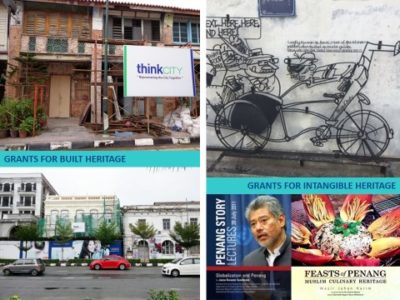
シンク・シティの助成プログラム例 Think City Grants Program
――貴方のプロジェクトには、ターゲットはいます?
Q: With your projects, do you have targets?
ダンカン:例えば、古い建物や昔からの生活を保存する利益を考える都市計画についいてのコースを開催したとしましょう。ターゲットは一年で20名の参加者だとすれば、私たちにとっては簡単に達成できます。しかし、それが何だというのでしょうか?例えば、2~3年後、「この建物はこのコースによって保存されたのです」と言えるでしょうか?これが私たちの直面している問題です。率直にいって、私たちはこの問題の解決方法はまだないと思います。
Duncan: For example, we run the course on urban conservation planning which means teaching city planners about the benefits of conserving old buildings and ways of lie like the way we have streets, existing infrastructure etc. So we can have a target of 20 planners in this year, but that’s easy for us to achieve. But so what? Can I, in 2-3 years time, go and say ‘that building was preserved because of this course’? This is the problem we actually do face. To be honest, I don’t think we really found the good resolution for this.
ジア: 例えば、1年目のコースに参加したヨハンは、後に都市再生促進活動家としてジョホという地域で活動しています。現在、コミュニティグループを立ち上げ、地域再生プロジェクトに取り組んでいます。市民が使うサッカー場や野球場の整備監督、コミュニティホールをもっと使いやすくなど様々なことに取り組んでいます。これが私たちの影響ではないかと考えます。
Jia: But you know, Johan, he attended YR1 and he has become a city rejuvenation activist in Johor. He is now going around setting up community groups, making sure the community hall and football base is safe and we have an impact like that.
ダンカン:しかし、それと同時に問題もあるのです。例えば政府機関から参加した女性は、6ヶ月もたたないうちに違う部署に異動になってしまいました。ひとつの機関から1名しかコースに参加していないとこういった問題が起こります。また異動にならなくても、その部署には20名ほど同僚がいるわけでたった一人の声が通るということはないのです。だからこそ、私たちはもしこのようなコースを開催する場合には少なくとも2~3名同じ機関から参加することを条件としています。私たちにはこのようなゴールやターゲットをもっていますが、こういったことは実践していくなかで生まれるものでもあるのです。
Duncan: But at the same, a woman from City Council, she moved to another department, using her skills and moved again. So if you have only one person in City Council doing the course, and get moved to different department or even if don’t get moved to another department, there are 20 others working at the same department, one single voice will be lose. So what we have decided is that if we are going to do this course, we have 2-3 people from one organization doing the course. We do have this goals and targets, but they sometimes evolve as we learn.
1月に企業メセナ協議会の招待である石油会社を訪れ、彼らが行っている芸術文化支援活動の話をしているとき、驚いたことがありました。。私が「活動が成功しているか否かどのように評価するのでしょうか」と聞いたとき彼らは「支援している芸術がよければいい」といった感じで、芸術のために芸術を支援している印象を受けたのです。私たちの場合はそうではありません。芸術のための芸術支援ではないのです。芸術はあくまでも都市再生のツールのひとつです。
Duncan: One of the thing we are surprised when we went to Japan, was Tonen General. I remember asking them, ‘so how you engage that is success or not’, and they didn’t seem to have any answer like, ‘well if the art is good, they are almost doing for art’s sake’. Whereas for us, it’s not for a sake of arts. Art is a tool for urban rejuvenation.
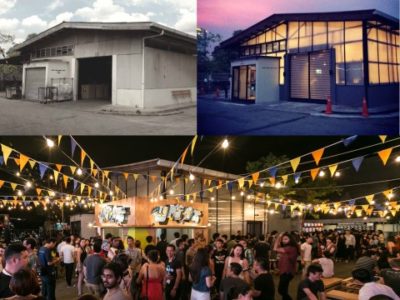
芸術を使っての都市再生 Arts as a tool to urban rejuvenation
例えば、先ほど話したLRTの駅で展開しているパフォーマンスですが、たった5人が立ち止まってパフォーマンスを見ていたとします。これが1年続いたとして、それでも5人しか立ち止まらない、ということになれば、この方法は間違っていると判断し、違う方法を考えます。たとえ、そこで行われている公演がすばらしいものだとしてもです。
As mentioned earlier about ‘Arts on the Move’ at LRT station, if we found five people only stop and watch it, or to see what kind of arts doing. For a year, if we still get five people watching, then we think it is wrong place doing it, we find elsewhere. Even if the art itself is fabulous.
――では、あなた方が直面している問題などはありますか?
Q: So what is difficulties or obstacles we are facing?
ジア:例えば、クアラルンプールでは人々からの信頼を得ることが課題です。コミュニティに信頼してもらうこと、市政から信用してもらうことです。私たちは経済的支援を求めません。資金の問題が取り除かれると、今度はあなたたちが本当に誠実だとどうしてわかる?とか、あなたたちが言っていることの真実味は?などとなります。
Jia: For KL, it is getting people trust us, getting the communities’ trust, and gaining the City Hall’s trust. We don’t ask for money. When the money is removed, people say ‘how do we know you are sincere, how do we know you mean what you say to help us?’
ダンカン:ペナンを見てみると、私たちは8年間そこで活動していますが、問題の1つにマーケティングの問題があります。イベントなどを行っても幅広い参加者を得るのが難しいのです。たとえば、トークセッションはトピックがなんであれ、50~60人はだいたいいつも同じ顔ぶれです。助成申請も同じで、だいたい同じ人々が申請をしてきます。
Duncan: Thinking about Penang, we have been for 8 years, one of the issues is marketing. You are not getting always diverse range of people involved. So if we hold a talk session or event, it’s always the same 50-60 people coming no matter what topic. When people apply for our grants, often the same group of people.
ジア:ペナンではいつも、多くの助成申請がありますが、クアラルンプールでは少ないのです。理由のひとつとして、申請書の書き方を知らない人が多いのだとわかりました。思っていることを言語化し申請書を書く能力の問題もあるでしょう。アーティストはいつもしていることですからとても慣れているので、別ですね。申請の50%はアーティストによるものです。しかし、コミュニティの人々はNGOなどでなければ、慣れていないのです。マレーシア人は難しすぎるものはやらないのです(笑)
Jia: In Penang, we had very many subscription for grants but in KL it’s less, we have found out that one of the reasons that people don’t know how to fill in the forms or scared to fill in forms unless artists. It’s a language ability to verbalize their thoughts to fill the form. 50% of forms are from arts organizations. That’s because they are so used to it. They used to write so many applications. But everybody also in the community feels if they are not NGO, they are not used it. Malaysian, if it is too difficult, they don’t do.
クアラルンプール支部設立から2年ほどしかたっていませんがなぜここまで大きくなったかというとコミュニティに赴き手助けをするスタッフが必要になったからです。わたしたちは彼らのアイデアや考えを書面にし企業がわかる言語に修正し、私たちの助成元に渡せるようにします。これもまたファシリテーターのプロセスですね。
Reason why our team has grown in because at a start-up level, KL is only 2 years/2.5 years, we need people to go out there and hold hands to certain extent to the community. So we have been able to put their thoughts into the corporate language, so our funders understand. Again, that is the part of facilitation process.
ダンカン:もうひとつは私たちがしていることを理解していない点です。私が「都市をよりよい場所にする活動をしています」と答えると、皆新しいビルや建物が建つのだと考えます。そして、私が「古い建物や商店街を支援しています」と説明すると「本当に?なぜそんなことをするの?」となるわけです。
Duncan: Another challenge is people not understanding what we are doing. If I say, ‘we try to make city better’, then they start thinking new buildings starting to build. They we say, ‘no, we are supporting old shops and houses’, then we get a response like, ‘really? Why do you want to do that?’
ジア:それに、この都市再生の分野は比較的新しい産業ですよね。
Jia: This industry is new, Urban Rejuvenation is new.
――寄付者/企業と人々 /コミュニティを結びつけたりするのですか?
Q: Do you connect between possible donors/corporation and people/community?
ダンカン:今行っている緑化プログラムはもともと、建築家からの提案でした。彼らは、緑化のレンガの壁があるビルに庭みたいなものを造りたいといいました。彼らと話をし始めたとき、一階に住む住民たちが責任を持って植物の世話をするのだということもわかりました。次に大家さんはどう思うのか?大家さんがこのプロジェクトに賛成することはとても重要なのです。ですから、大家さん、ビルの所有者、住民、それからデザイン設計を担当する第三者機関、を引き合わせ合意に至ったのです。それから私たちは彼らに企画書を求めました。リノベーションの体質からいっても、シティ・ホール(市政)からも支援をもらうことが必要だからです。それから、私たちはシティ・ホールを訪れ、「彼らがやりたいことはこれで、このスペースで行います」と提示したのです。
Duncan: This greening program, is approached by an architect. They said they had a building want to do some green wall like a garden and plants. So when we start talking to them, we understood that tenants on the ground floor who will be responsible for taking care of the plants. So what does the landlord think? And it is important for the landlord to agree with the idea. So we got building owner, tenant and their party responsible for design, committed to this kind of things. We also asked a planning information for this because of the nature of it, to get a support from City Hall. So we visited City Hall, ‘look, we have this space, this is the plan what they want to do’.
ジア:そうしたら、シティ・ホールはそのスペースにあるホール所有の6つの駐車スペースを取り壊して、庭と休憩エリアに変えたいと言ってきました。
Jia: They wanted to remove six parking spaces as a result to take all parking bay into a garden and sitting area.
ダンカン:また、このプロジェクトに関しては、アメリカのシティ財団も支援してくれています。このプロジェクトは関わっている人だけの利益ではないのです。つまり、ただ単に建物がよくなるだけではなく、たとえば、その地域の近くには何校か学校もあるので、生徒がここに来て食べもの・植物について学べるクラスを実施するなど機会を与えるのです。どのようにして食物を育てるのか、学べるのです。
Duncan: And at the same time, City Foundation is contributing to this overall project. It cannot be only for your own benefit. It is not just building look nice, what was proposed is to have classes for students as there are a couple of schools nearby, so students come down and lean about edibles, how to plan edible food.
ジア:それにこのプロジェクトは車文化から歩く文化に戻すという意味でもいいモデルとなります。
Jai: It is a demonstrative project to say that how to introduce pedestrian back into the city rather than a car.
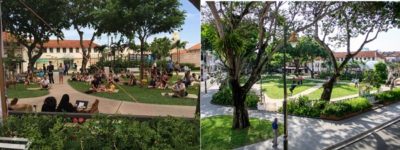
シンクシティによる公共スペースでの緑と人々のふれあい
Think City focuses on bringing ‘Green’ and people together
ダンカン:私たちがいま直面している様々な問題や課題は独立しているものではないと思います。街の緑化プロジェクトですが、ホームレス問題も、つながります。もし、とてもいい公園を作ってホームレスがそこで寝泊りをしてしまえば、他の人がその公園に行きたがらなくなるのではないでしょうか?マレーシアのホームレスは麻薬中毒者でもあるのです。親も、子供を連れてその公園に行くのは嫌でしょう。このような、プロジェクトを展開する上で、課題や隔離的問題を考えることは簡単ですが、しかしながらすべてはつながっているのです。問題は誰がそれを理解し、机上に挙げ、解決に向けた一番良い選択をしていくかということです。
Duncan: I think a lot of issues we are dealing with, they are not independent issues. For example for greening project of the city, we are looking at homeless issue, they seem two different thing, but they are inter-connected. If we build nice park, maybe homeless would go and sleep in the park. If they are sleeping in the park, maybe other people feel uncomfortable going to the park. A lot of homeless here use drugs. Parents don’t feel happy to take their kids. Just in the way that this grouping of isolation, it is easier to think about projects without issues and isolation, but they are not, they are all connected. Some shuffling on the table.
――なるほど。今日は本当に興味深い話をどうもありがとうございました。
Q: I see. Thank you very much for very interesting story today.
ダンカン・ジア:ありがとうございました。
Duncan, Jia: Thank you very much.
インタビュー6月15日
Interview held on 15 June
